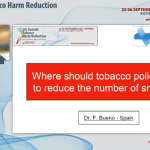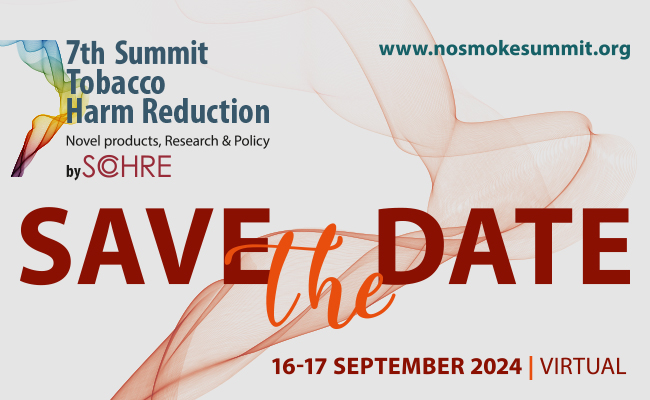Inviting the panel to comment on the subject “What is needed to showcase the benefits from harm reduction”, the moderator Dr Dimitri Richter pointed out that this discussion is taking place two months before the 10th COP of WHO in Panama, which, as it seems, is going to focus only on abstinence, and not on harm reduction. Referring to a previous comment of Prof. Farsalinos about how politics overcome science, Dr Richter expressed his hope that the discussion between science, WHO, and governments will lead to something better than the present WHO approach.
The first speaker, Mr David Sweanor, said that we should look at the public health history to see how we can implement effective harm reduction strategies. What is it that has caused life expectancy to more than double in the last 120 or so years, and why do we live so much longer, Mr. Sweanor asked. The reason we have tremendously limited diseases that used to ravage the mankind and the reason why planes, trains, and automobiles are massively less hazardous than they used to be is that we have used science, reason, and humanism.
We have known since half a century ago, that people smoke to get nicotine, but they die from the smoke. If people could get their nicotine without inhaling smoke into their lungs on an ongoing basis, we wouldn’t have this problem.
Mr. Sweanor added that governments and public bodies are losing credibility, because they have been misleading people. And when they lose the trust of the public, this affects us in a far broader range of issues, not just tobacco and nicotine. The recent pandemic is an example of what happens when the public doesn’t believe the authorities.
According to Mr. Sweanor, tobacco tax policies were certainly the single most effective strategy we had to reduce cigarette smoking, until alternative products came along. But we need the relevant data, Mr. Sweanor said emphatically. We have to push health agencies, governments and tobacco companies and get the data out; and then we need to compile them. We can find data from places like Sweden, Norway, Iceland, and Japan. If we have a range of viable alternatives, if we give accurate information to consumers and if we use risk-proportional regulation, so that more hazardous products are more heavily taxed, we can move people to the lower risk products virtually overnight. People are buying cigarettes every day, every day we have a chance to intervene. By offering a product that is massively less hazardous, doesn’t harm people around you, and is less addictive, and by making sure that it is available more widely than cigarettes, at a lower price than cigarettes, with more accurate information about relative risk.
Starting his speech, Dr Fernando Bueno, referred to the upcoming 10th Conference of the Parties (COP) of the World Health Organization’s Framework Convention on Tobacco Control (FCTC), and said that Spain, which is presiding the Council of the European Union this semester, is going to play a significant role as the coordinator of the common proposition of the EU. Dr Bueno, presented a document prepared by himself with a series of initiatives that Spain can promote during the presidency of the European Union, in preparation for the upcoming COP, related to three main concepts:
- Tobacco control policies should provide realistic solutions for smokers. As prevention and cessation have not succeeded in reducing the number of smokers, it is more necessary than ever to seek realistic solutions for smokers who are unable to quit using traditional products.
- Harm reduction as a complementary tool to prevention and cessation. The upcoming COP is an opportunity to discuss and find new solutions.
- Science as a cornerstone in the fight against tobacco. The debate on tobacco control must be based on scientific arguments and clinical data, moving away from mere opinions and emotional responses. This is the only way to make progress in the fight against tobacco. There is a wealth of scientific literature on harm reduction alternatives. Any debate on tobacco control that excludes science will only contribute to people continuing smoking.
We need to use international experience as a basis, Dr Bueno said. Numerous countries around the world have already successfully implemented policies that combine stricter regulations on traditional combustion products with harm reduction tools for adult smokers, with remarkable results. Nicotine is not a problem; it is tobacco combustion where the greatest harm to health lies. Therefore, the fight against tobacco should primarily focus on combatting traditional cigarettes.
New Zealand despite its success in reducing smoking rates shouldn’t be seen as an example to be copied by other countries, Dr Marewa Glover said, because anti-smoking measures should reflect the particularities of each country. She stressed that education of the public is number 1, not tax. In New Zealand taxes are so high relatively to income, that the main group that smoke―the lowest socio-economic group―can often no longer afford to buy cigarettes legally, and we see other problems arising; they turn to the black market, or they cut money from their food budget. And it’s not safe for young people, especially young women, to go to the black market. So, there are negative consequences of many policies, especially for the lowest socio-economic groups. Good policies should consider the negative consequences, Dr Glover stressed. However, people on Tobacco Control do not want the negative consequences to be talked about.
Dr Glover then talked about the importance of compassion. She expressed her joy to see so many medical doctors in the Summit focusing on the patient, being concerned about the patient, showing a lot of compassion for people who smoke, and understanding about dependency. In New Zealand they used to understand about dependency, but people on Tobacco Control have become very frustrated at the very slow rate of decline in smoking, and compassion is gone. “People who smoke have been demonized, some of them say they feel they are treated like lepers,” she added. They are being pushed to smoke outside and hiding.
She referred to the very strong prohibitionary vision that now prevails in New Zealand, according to which even vaping will be prohibited once cigarette-use rates are low enough. But they are already starting to do that, Dr Glover said, when almost 20% of the lowest income groups are still smoking. It’s too soon, the speaker commented and stated that she does not support it. It’s not healthy to live under an authoritarian rule; it causes depression, anxiety, and leads to health conditions, she concluded.
When Dr Richter commented that it seems that New Zealand is not just turning to harm reduction, it’s practically turning to punishment, Dr Glover agreed and depicted very vividly how people who smoke on the street are practically being abused. The marginalization is quite severe, and sometimes people who smoke are denied accommodation, or jobs. Finally, she pointed out that the Secretariat of the FCTC has already a vision to apply the same strict framework to reduce alcohol drinking and obesity.
Prof.Konstantinos Farsalinos then commented that what we are missing is apply science into policy regulation. Instead of having science guiding policy regulation, we have policy guiding the science. We have people who decide that some product is bad, and then are looking for evidence to support their predetermined position. That’s why we see such a level of unprecedented cherry-picking or even mis-presentation or misinterpretation of evidence; to support all the predetermined positions of regulatory bodies. He referred to the example of the report of the European Commission on harm reduction products, which was made by scientists who had never worked on tobacco, and it was the epitome of cherry-picking; it discussed about the cardiovascular and carcinogenic adverse effects of nicotine, without mentioning a single of numerous epidemiological studies on snus, and even on NRTs, which show that there is zero cardiovascular risk and almost zero cancer risk from using nicotine.
He also mentioned that at a past congress of the American Heart Association, studies on mice that developed atherosclerosis in the aortas when they were exposed to tremendous levels of nicotine were presented; totally ignoring other evidence, like a study carried out by the Karolinska Institute, which showed zero risk of having a stroke among snus users compared to non-smokers, non-users of any product. Why do we choose to trust animal and cell data, when there are epidemiological data? And why do we keep insisting on generating animal or cell toxicology data, while we are completely ignoring real-world epidemiological data?
Prof. Farsalinos then used the example of Sweden and the European Union, to showcase how bad policies may be applied. Today, Sweden is the only smoke-free country in the world, and of course in the European Union, despite the fact that nicotine use rate in Sweden is similar to the EU nicotine use average (about 24%). However, in Sweden the vast majority of nicotine use comes from snus, whereas in Europe it comes from cigarettes. As a result, death rates from cardiovascular disease, lung cancer, and cancer in other organs are half or even less in Sweden, compared to the rest of the European Union. So, we already have a real-world example, with the best possible long-term epidemiological evidence about reduced risk. And what did the European Union do? They banned snus. “It is unbelievable, it is a public health scandal”, Prof. Farsalinos said emphatically. The paradox gets even worse, he added, given the fact that the US FDA has approved a reduced risk claim for snus, whereas Europe has banned the product, while allowing cigarettes to be sold legally.
Having been a smoker himself, Mr Martin Cullip, spoke on behalf of consumers, saying that consumers are using nicotine products, they know that they work for them, and they try to do things and influence governments and regulators. He denounced the fact that the WHO won’t let the consumers speak in a way to affect the process, as well as the fact that the WHO is not looking for benefits; it has preconceived policy proposals and ignores increasing body of evidence showing that harm reduction products are beneficial.
He added that we cannot wait 20 or 30 years to gather more scientific data, because regulators are regulating things now and they are banning harm reduction products all over the world. So, we need to get our messages out, and we need to be making these messages now, because the other side is making all sorts of claims, most of them based on no science or whatsoever. As an example, Mr Cullip mentioned a recent article on the Daily Mail about some doctor in California who said that vapor burns at a higher temperature than cigarette smoke and causes “pop-corn lung”, so people will barbecue in their lungs.
He also used the example of snus to show how beneficial products can be banned and stay banned for decades. He said that these products have been used for over 200 years and we have 50 years of epidemiological evidence on them. So, if we allow all these harm reduction products to be banned now, then we can wait for 60 years to get those products back; combustible cigarettes will be the only legal product in the world. We must stop it, and we need strong messages to cancel the misinformation that is coming from the other side, Mr Cullip said.
Dr Heino Stover presented data about Sweden, which is the country with the lowest share of male smokers in the EU, and it is doing much better than the average of the EU in terms of male smoking-related deaths. Data show that some 2.890.000 deaths could have been averted in the EU, if the example of Sweden was followed. Where can this success of Sweden be attributed? Is it tobacco control policies or is it harm reduction approaches?
If we look at the tobacco control policies, Sweden is not in any way avant-garde in the EU, as the introduction of advertising bans or health warnings started much earlier in other countries; the same stands for the introduction of any kind of smoking ban.
If we look at the harm reduction approaches, and of course snus, its sale is currently prohibited in all other countries, except Sweden. Snus has a long-standing tradition in Sweden and the increase of use of snus is paralleled by a decrease of use of combustible cigarettes. The relative harm of snus is considered very low.
So, Sweden has adopted many tobacco control approaches, but it has not done so to a greater degree than other European countries; yet Sweden is the first country in the EU to become smoke-free. The fact that a non-smoking nicotine delivery system was readily available and widely used seems to be the most likely explanation for Sweden’s great success in reducing smoking rates and smoking related disease.
In the light of rapid changes to the nicotine market, with the introduction of e-cigarettes and heat-not-burn products, we need policies that take the relative harms of nicotine into account. The example of Sweden shows that accepting less risky nicotine administration saves lives.








